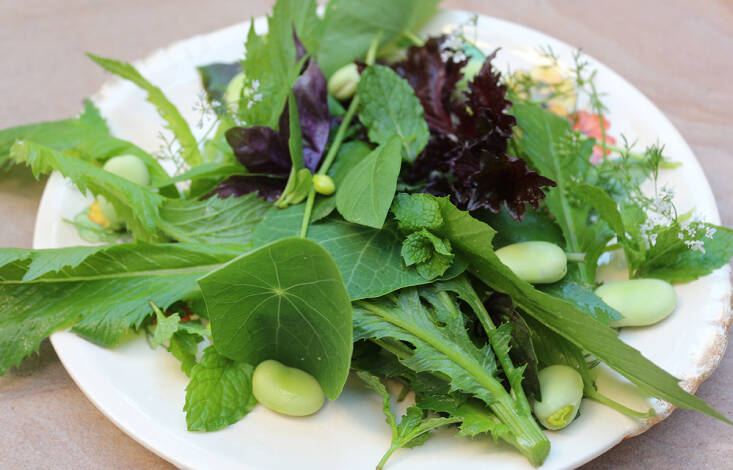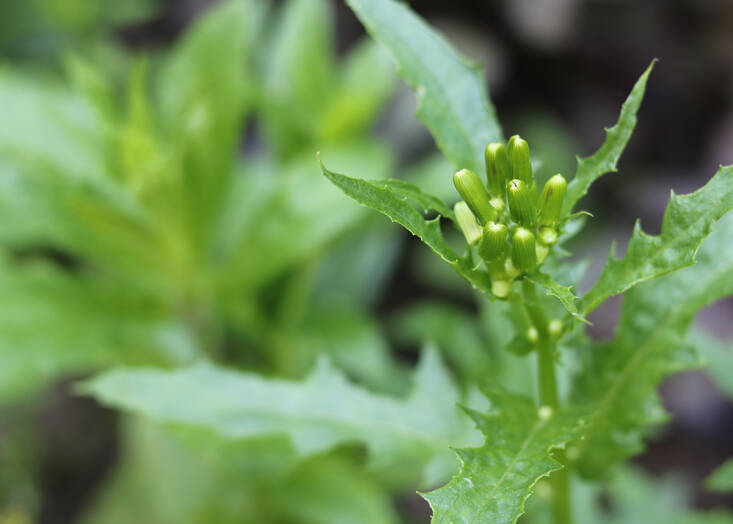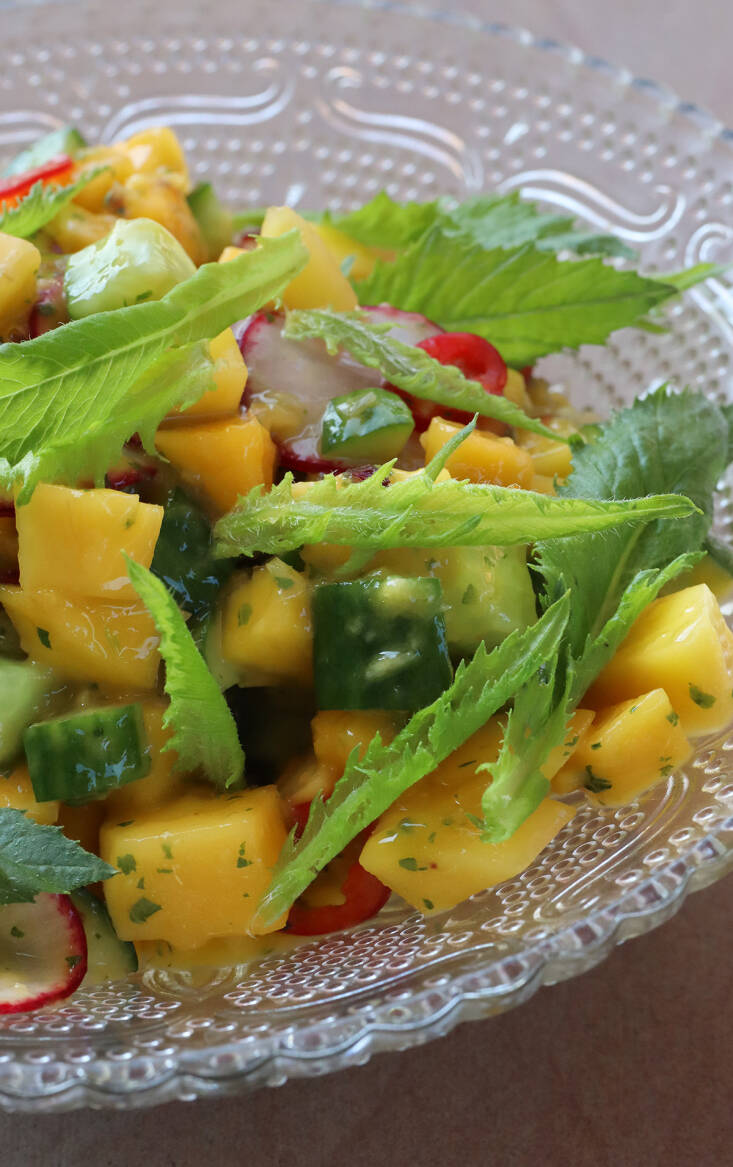What is the herb that spells summer? Basil, scattered across ripe tomatoes, or in pesto? Cilantro, chopped into guacamole? Or is it American burnweed, pulsed with mango into a dressing for a spicy salad? “American…what?” you might ask. It’s a North American herb whose aromatic leaves are ready to harvest in the sultriest days of July and August. Its aroma is as pungent as cilantro, but more perfumed, like shiso, with the charisma of epazote and the punch of culantro (with some Thai lime skin thrown in). In short: It is wow. Also virtually unknown as a culinary herb in the kitchens of its native range.
Photography by Marie Viljoen.

In Central Park’s North Woods, in the sticky summer of 2014, I met this unfamiliar plant for the first time. Flanked by the flowers and first, green berries of pokeweed (a misunderstood native edible), its herbaceous stem, surrounded by handsome leaves, grew almost four feet tall in the dappled shade. Its stature reminded me of wild lettuce, but the intense scent released by a crushed leaf was distinctly un-lettuce-like. My cooking instincts began to ping wildly. What was it? I took pictures, and collected some leaves. My American burnweed adventure had just begun.

Botanically, American burnweed is Erechtites hieraciifolius, and there are at least two varieties. It is an indigenous annual and a member of the Asteraceae family. Its common name alludes to its association with areas of forest that had been cleared by burning. Other common names include fireweed (not to be confused with the pink-flowered species of Epilobium, also edible), and pilewort. Wort is a suffix often attached to plants associated with a medicinal use, and the pile, well, that says all. That etymology is interesting, because it turns out that American burnweed is used in some parts of the world to treat hemorrhagic complaints.

My initial searches for this aromatic herb’s traditional American culinary uses came up close to empty. Hearsay. Speculation. Very little personal experience. There were dismissive comments about its “rank odor,” followed by downright rudeness, like: “Very unattractive in appearance, and ill-scented besides.” That was R. M. Harper, writing a 1944 report on weeds in Alabama. Native Americans used American burnweed medicinally, treating poison ivy rash, among other ailments, and it has been similarly useful in Central and South America. It is high in terpenes, such as myrcene, which is also found in lemongrass, basil, and cannabis. In Japan E. hieraciifolius has been found to be efficient at assimilating atmospheric nitrogen dioxide, making it a potential botanical “brick” in living green walls planted near buildings or flanking highways to sequester pollutants from car emissions or other industrial sources.*
* The Biology of Canadian Weeds, Canadian Journal of Plant ScienceVolume 92, Number 4, July 2012

At long last, in my hunt for dinner, I reached the digital shores of Indonesia and Malaysia, where this American weed, along with its tropical counterpart, Erechtites valerianifolius, has enjoyed a solid culinary tradition as well as some serious study, which reveals high vitamin A, protein, and zinc levels. It was that geographic culinary association, and burnweed’s strong relatability (at least to my palate) to annual herbs like basil and mint, that guided my first kitchen games.

How does American burnweed taste? It starts off as herbal, then floral (like rose petals), followed by a bitterness, before all those elements blend. You may love it or hate it. The herb’s pungency suits strong or complementary flavors: Fish and soy sauces; braises with miso. Peanuts. Fresh chiles and lime. The sweetness of peach, mango, and pineapple; the heat of ginger. Slow adobos, Filipino-style, with coconut milk. Mexico beckons, with smoky chiles, and tomato. The tiniest leaves, from the tip of the plant, are a perfumed counterpart to delicate sushi, or sour ceviches. And they hold their own in bold salads.

In my first research (which I refresh periodically) I also found references to alkaloids, which American burnweed contains (as do some familiar foods, like nightshades, coffeee and tea). Consumed in sufficient quantity (no one can tell us what that is, but certainly this is not a plant to juice, for example), they could cause harm, a warning never to ignore. But in the context of dinner, and using burnweed as a flavoring, an overdose would be hard to achieve.

Our first meal with burnweed has now become a rite of summer’s first humid days: bites of soy-marinated, coal-grilled beef (or chicken), wrapped in an aromatic young burnweed leaf. Mango salad follows close on its heels, tossed in a dressing of puréed fruit with a few burnweed and mint leaves thrown in.

Before it flowers, American burnweed’s juicy stems are tender enough to eat as a vegetable or relish. They should be easily snappable by hand; any older and they are tougher and more bitter. After blanching the trimmed stems for about 5 minutes, I dunk them in cold water, dry, slice into rounds (or keep whole), season with salt, dress with a nutty oil like sesame or walnut, and combine with just-toasted sesame seeds for contrasting crunch.

When the plant grows tall and sturdy, the leaves are useful as wraps, if you like their taste. Once the flower buds form, you might like to ferment them, pickle them, and turn them into capers.
How to Prepare American Burnweed
- Burnweed wilts rapidly once gathered: At home, re-cut the tender stems, plunge the leaves and stems into a large bowl of cool water, and wait until it has revived.
- When it has perked up and looks fresh again, dry the leaves and stem well. Wrap, and keep them in the fridge. (If left wet, the stems and leaves will discolor and darken quickly.)
- Clipping off the larger leaves and stacking them separately from the stem is also a good way to keep them fresh, longer.
- Tender leaves early in summer or near the tip of the plant are delicious raw; try with fruit salads or ceviche.
- More mature leaves can be used raw for wrapping, with a dipping sauce alongside.
- Blanch pieces of stems or leaves before including in stews or curries: they favor the sweetness of coconut milk, the acid of citrus, the heat of chile, or funky saltiness of fish sauce or soy sauce.

Mango, Cucumber and American Burnweed Salad
Using both ripe and unripe mangoes gives a wonderful balance of sweet and tart, soft and crisp to this juicy, summer-tonic salad. Substituting freestone peaches for mango is a delicious alternative.
- 1 large ripe mango, peeled and cubed
- 2 large unripe mangoes, peeled and cubed
- 2 lemons (you’ll need 3 Tablespoons juice)
- ¼ teaspoon salt, divided
- 3 Persian cucumbers, cut into chunks
- 3 radishes, shaved thinly
- 1 Tablespoon honey
- 1 Tablespoon fresh red chile slices, or to taste
- 3 large American burnweed leaves, plus tender tips of 3 stalks
- 10 mint leaves
Place the prepared mango in a bowl, with a tablespoonful of lemon juice and half the salt. Toss lightly. Remove half a cup of the seasoned fruit and reserve for the dressing. Add the cucumber and radish to the mango in the bowl.
For the dressing: Place the half cup of seasoned mango in a food processor or blender. Add another tablespoonful of lemon juice, the honey, the rest of the salt, the oil, the chile slices, the 3 burnweed leaves and the mint. Pulse until smooth. Remove and toss with the ingredients in the large bowl.
Plate, and garnish with the remaining burnweed tips.
See also:
- Invasivore: Mugwort the Herb vs. Mugwort the Weed
- Roses in the Kitchen: How to Bottle Their Sweet Fragrance for Syrups and Drinks
- Bayberry: An Herb Native to North America












Have a Question or Comment About This Post?
Join the conversation (0)